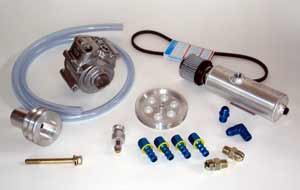 |
 |
PART
2 |
By Jay Storer
2/9/05 |
[Part 1] of
this story may have convinced you that a proper crankcase
evacuation system is right for your car - we could all use
a tenth or two - but how do you choose the best setup for
your application?
 |
| A complete vacuum system includes
the pump, crank and pump pulleys, belt, 200-psi hose,
push-on fittings and all hardware, plus a baffled breather
tank and a vacuum control valve. |
Tailoring pumps and vacuum capacity for various
engine combinations involves three factors in the pump: pump
displacement, number of vanes, and pump speed. The first is
the biggest factor and mostly a result of pump-body length.
The longer pumps have more displacement, and a three-vane
pump outflows a two-vane, but a four-vane only flows a little
more than the three-vane, so there is a diminishing return
on number of vanes.
Within the three basic sizes of pumps GZMS offers, the Sportsman,
Pro and Super-Pro, variations to suit engines size and other
needs are achieved by varying the pump’s speed. Airflow
from a vacuum pump increases with speed, i.e. increasing the
pump speed by 10 percent equates to flowing 10 percent more
airflow, although the increase in airflow flattens out at
about 5000 pump rpm. Greg Zucco keeps his pumps below that
threshold by underdriving them by 37 percent (63 percent of
engine speed) with the use of a 5.5- inch-diameter pulley
on the pump. All of the GZMS kits include a crank pulley and
pulley mounting kit for the correct ratio.
 |
| A vacuum control valve like this high-flow
GZMS billet model can be used with any pump and adjusts
for a range of 5-25 inches of vacuum. Conventional wisdom
suggests keeping the maximum vacuum to 12-15 inches. |
If your needs fall somewhere in between kits, there are optional
pulleys of 4.5-inch (25 percent underdrive) and four-inch
(8 percent underdrive) to spin a pump faster. Pump selection
must take in a number of factors, but to use a simplistic
example, if you run an engine of less than 427 cubic inches
with typical wet-sump oiling and normally-aspirated on gas,
GZMS would recommend their VP101 Sportsman pump kit with 5.5-inch
pulley. That same engine with low-tension rings and maybe
a small nitrous dose (up to 150 hp) would use the same pump
but spin it a little higher with a 4.5-inch pulley. That same
engine but with a bigger dose of foo-gas or a supercharger
would call for either the VP101 at 75 percent or the VP103
Pro pump spinning only 64 percent of crankshaft speed. Increasing
speed on these pumps doesn’t increase the parasitic
drag, as it would on centrifugal-type vacuum pumps.
An accurate vacuum gauge on your racecar will tell you if
you’re over-evacuating the engine. There are some engine
builders who don’t like to see too much vacuum on engines
that don’t have pressure-feed-oiling of the wrist pins,
theorizing that removing too much oil-mist from the system
may rob some lubrication from the pins. If you install a vacuum
gauge in your evacuation system, you should glance at the
gauge when you’re at your top rpm going through the
lights. GZ Motorsports recommends that you have no more than
15 inches of vacuum showing (remember we’re sampling
the crankcase vacuum, not the usual intake vacuum most automotive
vacuum gauges are intended to read).
In many cases, the efficient GZMS pumps can exceed this number,
and so most kits are ordered with an adjustable vacuum control
valve that allows tailoring the vacuum for your specific application.
Eventually, as wear may reduce the total vacuum of a pump
and ring wear may increase your engine’s blowby, the
valve can be adjusted to maintain the proper 12-15 inches
you need for maximum power gain. The valve just lets a little
less air into the system to compensate for engine wear.

|

